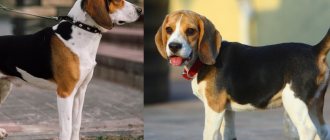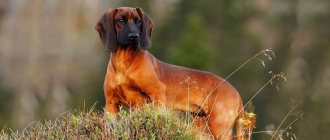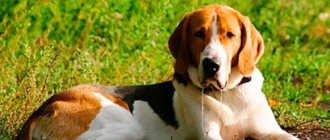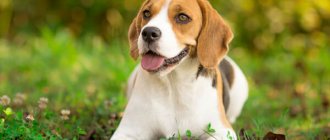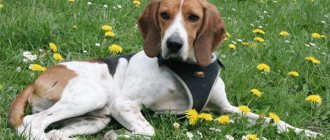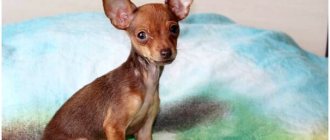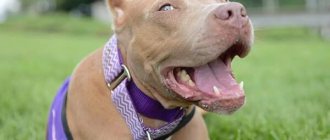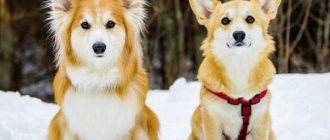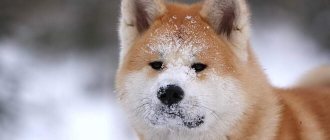External differences
It is difficult for ordinary people to distinguish between a beagle and an Estonian hound. Dogs really look alike. But there are several fundamental differences in their exterior.
The Beagle is a small but strong dog with a short, tri-colored coat. The Estonian Hound is larger than its ancestor, proportionally developed, also smooth-haired, but with hard guard hair.
The Beagle is recognized by the FCI, in contrast to the Estonian Hound.
A detailed comparison and differences between the breeds are presented in the table:
| Characteristic | Beagle | Estonian hound |
| Height | 33 – 40 cm | 45 – 52 cm males (breeders), 42 – 49 cm bitches (breeders) |
| Weight | 10 – 18 kg | 12 – 25 kg |
| Frame | Elongated, longer than height. The back is flat with a short flexible loin. The chest drops below the elbows, the stomach is moderately tucked in, the neck is long and curved. | Long, with prominent withers and sloping croup. The back is straight, the lower back is convex. The chest reaches the elbows, the stomach is slightly retracted. |
| Limbs | Straight, parallel, standing under the body, muscular. | Dry and bony, straight, elbows pressed to the body. |
| Paws | Round, gathered into a ball, with short claws. | Oval, tightly compressed, large claws. |
| Tail (rut) | Of medium length, stands high, straight, without kinks, does not fall over the back, and is abundantly covered with hair. | Saber-shaped, long - reaches the hock joints. Standing is average, does not rise higher than the back when excited. It appears thick due to its thick fur. |
| Head | Large, dome-shaped, not pointed, with a defined occipital protuberance. The stop evenly divides the area of the back of the head and nose. | In the shape of a wedge - sharp at the muzzle and blunt at the back of the head. The transition from forehead to muzzle is not sharply expressed. |
| Ears | They reach the tip of the nose, stand low, thin, close to the cheeks, with rounded ends. | Thin, hanging along the edges of the muzzle, adjacent to the cheekbones, standing in line with the eyes and reaching the middle of the muzzle. |
| Eyes | Walnut or dark brown in color, planted deep. | Dark brown with black eyelids, standing slightly askew. |
| Nose | Black or light brown in beagles of light colors. | With a black lobe. Shades of brown are allowed in light-colored dogs. |
| Lips | Slightly hanging. | The mouth is tightly closed and dry. |
| Bite | Scissor-shaped. | Same. |
| Wool | Short, does not get wet. | Short, hard, with a weak undercoat. |
| Color | Black-red-white, blue-red-white, badger, white with lemon, red or red. The tip of the tail is painted white. | The classic color is black and piebald with ruddy spots. A color with a white background, on which there are areas of black, yellow, and red shades, is allowed. Possible brown tan. The limbs and tail at the end are white. |
Origin story
In the early 90s, a breeder from Wisconsin (USA), Vols Havens, first began breeding puggles. It was he who came up with the name for mestizos, combining parts of the names of the original breeds in one word. In Russian it would sound like “mogl”, but in English pug is pug, so Haven got puggle.
Havens was the first person who wanted to officially register puggles with the American Kennel Club of hybrid breeds and began their targeted breeding. Before him, in the 80s, American breeders already received puggles when they experimented with creating new breeds.
Mixed breeds that are not recognized by canine associations are usually called designer breeds.
After 2000, Havens, along with his dogs, came under fire from checks and inspections. Breeding work was suspended by the American Kennel Club, and in 2008 it was closed by the state Humane Society.
To this day, American breeders are prohibited from breeding puggles with puggles, but it is possible to produce first-generation mixed breeds and sell them under this name.
Video about the designer puggle dog breed:
Character difference
The difference between beagles and Estonian hounds is also manifested in temperament. Both dogs are lively and active.
Photos of beagles.
But if beagles are eternal energizers who love everyone, then Estonian hounds are calmer and more balanced. Greyhounds from England consider all people to be friends, while greyhounds from Estonia especially emphasize family and owner.
The character of dogs has been transformed to meet the requirements of selection. The difference is that “Estonians” are still working dogs, while beagles today are used mainly as companions.
Compared to the Estonian hound, the beagle looks like a relative from the village. He is ready to communicate with everyone, gets involved in people’s affairs without shyness, and constantly demands attention.
Photo of an Estonian hound.
The Estonian greyhound is distinguished by its prudence and intelligent manners. She also needs attention, but she will not demand it and impose herself.
The differences are more pronounced in comparison with behavioral aspects.
Relationships with family
Beagles and Estonian hounds are equally loyal. But if the former love everyone and do not single out one person separately, then the latter unquestioningly obey only the owner.
Interaction with children
The Beagle has a cheerful disposition. He is ready to tinker with children for hours, run with them, play and play pranks.
“Estonians” are not suitable for nannies. Of course, they will also be happy to play with the children and will not bite the baby. But they know that their task is hunting, not babysitting.
Both pets are not left alone with preschoolers. When playing, dogs can knock down or push children.
Trusting strangers
The differences are most evident on the street, when the beagle and the Estonian hound walk together.
The Beagle is distinguished by its love for everyone. He will follow a gentle stranger with a treat or toy in his hand. It's easy to steal a pet, so don't let him off the leash in crowded places.
The hound, on the contrary, is wary of strangers. She doesn't even trust family friends. And she would never approach strangers, no matter how much they lured her.
Relationship with other pets
For both breeds, pets are prey. They enthusiastically chase cats, rodents and birds.
However, beagles can be trained not to touch animals with which they grew up. Hounds have no such tolerance.
The dogs get along well with their relatives and love to walk together. However, "Estonians" are more interested in tracking down prey than playing with other dogs.
Leadership
Both types of hunting dogs do not tend to dominate. They easily obey and recognize their owner as the leader of the pack. True, in adolescence, beagles show differences in character: they try to take the top in the hierarchy. Whereas “Estonians” are deprived of such qualities.
Learning ability
The Beagle is a quick-witted and smart dog, it picks up commands on the fly. But at the same time he is wayward and cannot concentrate on one thing for a long time. Therefore, training is difficult and requires patience and consistency.
Unlike the Beagle, the Estonian Hound is human-oriented. She is diligent, quickly remembers commands and carries them out unquestioningly.
Still, a greyhound from Estonia is not suitable for beginners. If there are no problems with the general training course, then it is difficult to train a pet to hunt when there are no appropriate skills.
Working qualities
Estonian hound.
Beagle.
The key differences between beagles and Estonian hounds are their hunting skills. The latter herd hares, lynxes, and foxes. They can track roe deer, wild boars, and, in the off-season, birds.
Hunters prefer not to train Estonian hounds to follow the “hoof mark”. It is easy to pick up, unlike hare tracks. As a result, the greyhound will only track ungulates.
Beagles are designed for hunting rabbits, hares and other rodents. They will not be able to handle a larger animal.
Differences also appear in the type of work. “Estonians” simply track and drive the prey to the hunter. And beagles act in a pack and drive down game.
Pros and cons of the beagle
Pros:
- Not aggressive towards other dogs or people.
- Loves children.
- Affectionate and devoted.
- Cheerful and playful.
- Can keep company even on a multi-day hike.
- His coat is easy to care for.
- Unpretentious in feeding and keeping conditions.
- With proper training it can become a good hunting dog.
- Despite its small size, it is strong and durable.
- He is in good health.
Minuses:
- Stubborn and self-willed.
- Can't stand loneliness.
- Big manipulator.
- Not suitable for inactive people.
- Trusting of strangers...
- He loves to eat.
- Needs long walks.
- Prone to escape.
- Some beagles may bark and howl when left alone.
- It is not suitable for a child under seven years old, as he simply will not be able to cope with such an active and strong dog.
Beagles can only be let off leash in enclosed areas, otherwise they may run away.
Content Aspects
You can keep an Estonian hound or beagle in an apartment or in a private house. Semi-aviary housing for “Estonians” is also allowed.
Due to their compact size, they are suitable for any room. At the same time, dogs, active and tireless on the street, turn into quiet couch potatoes as soon as they see a comfortable sofa.
Beagles are closely monitored in the country house. These are famous diggers. Beagles love to dig holes under fences and run away. In contrast, greyhounds from Estonia calmly play in the backyard and do not run away.
Care
Grooming a Beagle and an Estonian Hound is not difficult. Enough:
- Brush the doggies every 4 to 7 days;
- bathe every 2 – 3 months;
- inspect the ears and skin of pets after walks for ticks and injuries;
- weekly remove wax from ears, nitrous from eyes, remove plaque from teeth;
- once a quarter, treat pets from blood-sucking parasites and helminths;
- vaccinate on schedule.
Dogs shed moderately in spring and fall. During this period, they are combed every day.
Beagles and Estonian hounds are clean, their coat does not get wet, repels dirt and cleans itself. However, like all hunters, dogs love to roll around in “fragrant” rotten meat.
In the house where a hunting dog lives, you cannot store or use perfumes, aromatic oils and candles, air fresheners, varnishes, paints, etc. Strong odors from household and cosmetic products irritate the olfactory receptors and impair the sense of smell.
Feeding
Estonian hounds and English beagles are unpretentious when it comes to food. There are no differences in diet for both breeds.
Dogs are fed a balanced diet based on lean meat or ready-made holistic or super-premium food, or, in extreme cases, premium food. You cannot mix food types.
Health
"Estonians" and English greyhounds are generally healthy dogs. True, there is a difference in life expectancy: the former live up to 11-13 years, while the average age of beagles is 12-15 years.
Common diseases include:
- otitis (long, drooping, tight-fitting ears - an ideal environment for bacterial or fungal infection);
- adenoma;
- cataract;
- glaucoma;
- iris dysplasia.
Typical diseases of beagles are epilepsy, intervertebral hernia, hepatic colic. The Estonian Hound is characterized by arthritis, joint dysplasia, congenital blindness and deafness.
Walk
Both breeds are active. They need long, vigorous walks, games and activities that exercise their muscles and brain.
Estonian hounds are more demanding. If beagles have adapted to the role of companions, then for hounds life without hunting is meaningless.
Popular types of Jack Russell mixes
Today there are many Jack Russell mixes, and each of them has interesting features and a unique appearance.
The most popular of them are shown in the photo below.:
- Jackshund – a cross between a Jack Russell terrier and a dachshund;
- Yorkie Russell – a cross between a Jack Russell and a Yorkshire terrier;
- Jackabee - a cross between a Jack Russell and a Beagle;
- Jack Chi - a cross between a Jack Russell Terrier and a Chihuahua;
- Cojack – a cross between Corgi and Jack Russell;
- Jackpoo is a cross between a poodle and a Jack Russell.
How to distinguish between puppies of two breeds
There are almost no differences between 2-3 month old cubs. All puppies are well-fed, cute, and have a similar appearance.
It is possible to distinguish a beagle puppy from an Estonian hound only at 5-6 months, when the breed's characteristics appear. But they usually take away babies up to 3 months old.
Therefore, when buying a puppy, you need to:
- see both parents live, especially the hatchling: a phrase like “mom is now at the dacha/walking with her husband/hunting, but we have a photo” is an excuse from unscrupulous breeders;
- check documents: pedigrees, passports, kennel registration documents, breeding permits, certificates of victories in exhibitions - for “Estonians” the latter must be field tested;
- invite an experienced dog handler or breeder - for the average person there are no differences in the breeds.
Where to buy a puppy
Despite the fact that international clubs and the RKF do not recognize such dogs, there are those who want to get such an unusual puppy. The cost of such pets starts from $500, but in Russia today there are no professional breeders of these hybrids.
In America, “first generation” offspring from mating pugs and beagles are offered for sale. Crossing puggles with each other is not recommended by the world canine community, so it is important to check the pedigree of the parents when purchasing mixed breeds.
Those who decide to get themselves an unusual puppy with an original exterior take on enormous responsibility for the future of the breed mix. It is recommended not to allow individuals of the same species to be mated. The best solution in this case is to sterilize the pet.
Important: Puppies of the second and subsequent generations are sold only by unscrupulous breeders.
Question of price
Differences also appear in cost. Thus, purebred beagles are sold from 30,000 rubles. The price reaches 60-70 thousand rubles for show class. You can get a puppy for 15-20 thousand rubles.
Estonian hounds are sold cheaper - on average for 15,000 rubles. You can find advertisements with a price of 5-7 thousand rubles.
You can buy beagles in the following nurseries:
- https://www.kennel-beagle.rf – St. Petersburg;
- https://www.beaglevista.com – Moscow.
“Estonians” are bred by the following breeders:
- https://sobaki.pro/index.php?m=Poroda&page=Poroda/Pitomniki&id=Esto&pit=2749 – nursery “Nazoro” in Moscow;
- https://iztsarevshchiny.rf – Samara region.
Owner reviews
Taras:
Puggles are really funny. They are very cheerful and outrageously active. I can’t imagine how they can get along in an apartment. Everything would be fine, but this howl... I wonder how the apartment neighbors behind thin walls can withstand it.
Elena:
My husband surprised me for my birthday and gave me a puggle. He, you see, liked the name. Zhorik is already three years old, and all this time I have been simply going crazy from this howl. And I’m generally silent about my favorite designer flower beds. It’s also a bundle of energy with a perpetual motion machine and no switch. In addition, our puggle is blunt-nosed and therefore snores a lot. But there are also advantages. He is very loyal, low maintenance and always manages to lighten the mood with his funny expression.
We look forward to your impressions of this unusual and energetic breed with the funny name Puggle.
Rate this article
Share
Leave a review
Who is better to have
A comparison between the Estonian hound and the beagle is impossible without the purpose for which the dog is bred.
If you need a companion, a family pet, or just an optimistic friend, it’s better to get a beagle. Plus, its size is smaller than that of the “Estonian”, making it easier to keep a pet in an apartment. The Estonian Hound is a serious hunting dog. Non-hunters are not advised to own one. Temperament, the desire to track and drive animals are the key differences of the breed.
Without work, “Estonians” are withering away. Often, after a year or two, inexperienced owners are looking for someone to give their pet to. It is difficult to part with a pet, but it is even more difficult to find a hunter who wants to take an adult, untrained dog.
Moreover, you need to remember that English beagles and Estonian hounds are not easy to train. If you can’t make circles in fields and forests for 3-4 hours every day, you should take a closer look at calmer dogs.
Hybrid health
The breed is very young; crossbreeds of pugs and beagles have not yet passed the test of time. Their genetic code is unstable. Dogs can be completely healthy or have hereditary problems inherited from two species.
Main types of diseases:
- Obesity.
- Articular dysplasia.
- Food allergies.
- Cardiac pathologies of various origins.
- Eye problems: cataracts, glaucoma, third eyelid adenoma.
- Nostril stenosis.
Dog names
For these energetic puggle dogs, any clear and simple nicknames are more suitable, such as:
- for males - Rich, Skippy, Archie, Tiger, Harry, Cooper, Fox, Schultz, Conor, Hamlet;
- for females - Courtney, Sunny, Becky, Floris, Bonya, Tasha, Emma, Maila.
These are just a few examples of names that may suit your pet. You don’t have to follow any recommendations, but name your pet the way you like.
Feeding
It is preferable for puppies to be fed their mother's milk until they are 3 months old. This will help strengthen their immunity. The transition to a new type of food should be carried out gradually.
Puppies are fed 6 times a day, adult dogs need 2 times. The diet should be balanced, enriched with vitamins and minerals.
When choosing natural food, consultation with a specialist is required, since only a correctly selected combination of components will help ensure the health of the pet and maintain its external attractiveness.
An approximate diet should include:
- 75% boiled dietary meat (rabbit, turkey, beef), it is acceptable to treat the dog with fish. All these products must be boiled.
- 25% of the diet is porridge from rice, buckwheat, vegetables and fruits.
It is acceptable to pamper your pets with fermented milk products, nuts and honey. These treats should be offered no more than twice a week.
Important! Salt and spices are not allowed in food. Also, you should not give any sweets or flour products.
The best option for feeding designer breeds is premium dry food, in which all products, mineral and vitamin complexes are selected in the required proportions.
Advantages
Among the advantages of the breed, owners highlight:
- Playfulness, activity;
- Affectionate, loving, friendly;
- Sharp mind, ability to learn;
- The ability to adapt to the owner (they will both watch TV and go on a hike);
- Good relationships with children, small rodents, cats;
- Not conflict.
Flaws
Each owner sees different disadvantages in a pet. For some, barking is a funny song, but for others it is an annoying noise. Puggles are difficult to raise; they need professional behavior correction at the selective level. Owners are often annoyed by:
- Mischief;
- Touchiness;
- Laziness;
- Stubbornness;
- Constant thirst for attention.
Silky Windhound
The Silky Windhound is a greyhound, created by crossing a long-haired whippet and a Russian greyhound. This breed is not yet recognized by the largest cynological communities; it appeared only in 1987.
She looks like a small greyhound, graceful, with silky hair. She is distinguished by her intelligence and high devotion to her owner. The Silky Windhound can be called a family dog.
What to feed a maltipoo
Most breeders recommend feeding the Maltipoo with high-quality industrial food. When choosing food, take into account the age, weight and physiological state of the animal. The amount of feed is calculated by weight. Do not increase the portion indicated on the package. It is also impossible to unnecessarily use dietary foods that are indicated for various diseases or that are low in calories. At first, the puppy should be fed the same food as the breeder. If you decide to feed your dog natural food, it is better to contact your veterinarian for help in creating a balanced menu.
American Eskimo Spitz
The ancestor of the American Eskimo Spitz is the German Spitz. But it is also believed that the Samoyed took part in the development of this breed.
The real pride of this breed is its luxurious, soft coat. In addition, they perform various tricks well and have been performing in the circus for a long time. They have the stubbornness and independence of the Spitz, however, they are the most flexible of the varieties of this breed.
This Spitz loves to frolic in the snow, but is very wary of strangers.
Walks
Puggle inherited hyperactivity from his Beagle parent. Therefore, the duration of energetic walks can gradually increase: from 15-30 minutes for a puppy to an hour for an adult .
It is not recommended to walk in extreme weather : both high and low temperatures can cause illness in your pet. But if there is an urgent need to go outside, we recommend that you use special clothing for dogs.
You should not let your puggle off its leash if you are in an open area. He may be distracted by the new smell and ignore your commands.
Other hybrid varieties
To what age do small, medium and large breed dogs grow?
There are several more mestizos, photographs of which convince of their uniqueness:
- The descendant of a pit bull and a Labrador looks very interesting, but in the bad hands of a frivolous owner it can become uncontrollable.
- Wier is a fairly rare dog - the result of crossing a German and a long-haired collie.
- Yorkshire strudel - a descendant of the York terrier and poodle - is a very dynamic creature, ready to become a true friend to a resident of the Moscow region or any other.
- Yorkie and Shih Tzu are an attractive, cute little one.
- Bullmatian is the name of the ancestor of the Dalmatian and the bulldog, a formidable dog on the outside, but a very good-natured dog on the inside.
- The Weimerman is a cross between a Doberman and a Weimaraner.
- The muzzle and ears of a whippet, the physique of a pit bull, the paws of a boxer - this is a description of an amazing hybrid.
- Bernudel. It can be obtained by mixing the breed characteristics of a poodle and a Bernese Mountain Dog.
- A snow-white giant with a brave heart - a cross between a Malamute and a Pyrenean mountain dog. It is not afraid of frost, although it does not have particularly lush fur.
A mixed breed of Yorkie and Shih Tzu will become a real favorite for the whole family.
Maltese (Maltese)
Today, decorative dogs are gaining great popularity among animal lovers. One of the most popular is the Maltese, which is considered one of the oldest breeds. She was created for communication: this snow-white dog is sociable and energetic. Maltese will fit well into any family and will easily acquire the status of everyone's favorite.
Leonberger
At the turn of the 30s and 40s of the 19th century, Heinrich Essig, councilor of the municipality of the city of Leonberg (southwest Germany), decided to create a breed of dogs whose appearance would resemble a lion, which was the symbol of the city of Leonberg and was depicted on the coat of arms. He crossed a Newfoundland and a St. Bernard and the result was a noble and powerful Lernberger. This dog exhibits excellent guard qualities, but can also become a companion dog. Despite their menacing appearance, dogs have a very balanced character, they have an active mind and are not subject to the desire to dominate.
